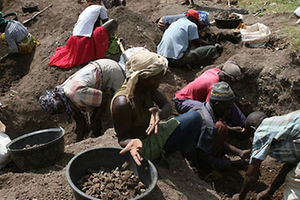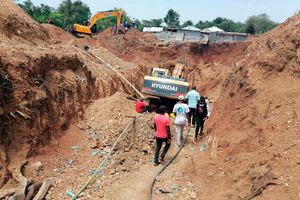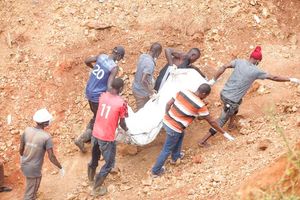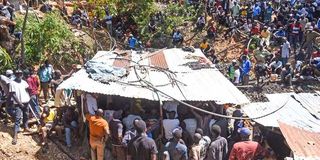
Relatives and members of the public wait as rescue operations go on at the Museno mine shaft on February 4, 2025 in Shinyalu, Kakamega County .Eighteen miners have been rescued so far.
The quest for the precious but rare gold in various areas across the country is creating an ever growing number of orphans, widows and widowers as unsafe mining practices cause deaths.
Government data shows that in the five years to 2022, Kenya lost 60 people in mining sites while 59 were injured.
The worst-hit county during that period is Kakamega, which lost 27 people. It was followed by Kisumu, which tied with Migori with 15 deaths. Taita Taveta lost three people over that period. The data is derived from the Auditor-General’s performance audit report on monitoring of artisanal mining operations by the Ministry of Petroleum and Mining.
Sunday Nation did a tabulation based on media reports about deaths in gold mines in the 10 years to 2025, and the result is that at least 89 people have died over that period while 65 have sustained injuries.
Over that period, the highest number of deaths has been recorded in Siaya County (22), followed by Migori (17), Marsabit (15), then Kakamega (14).
Beyond those statistics are Kenyans who have lost their loved ones and have been forced to make do without breadwinners.
Take the example of Petronila Musila, a widow left behind with five children in Lurambi, Kakamega County.
Her husband, Godfrey Shikote, died when a shaft caved in at Sigalagala, killing two.
“Life has become so difficult. I have to wash clothes or weed farms for my neighbours to afford a meal for my children. Debts have accumulated in the schools where my children are learning. I just don’t know how I will get out of this situation,” said Ms Musila.
In Lwesero village in Lurambi, the children of Cosmas Muteshi have been adopted by his brother, Timothy Mukosh. Muteshi died in mining shafts in Sigalagala on the night of April 11, 2020 due to suffocation.
In the neighbourhood is the grave of Elly Omondi, who perished in the same mines on April 13, 2011.
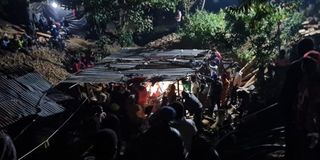
A gold mine collapse in Shinyalu, Kakamega County, has left several miners trapped and feared dead.
“He suffocated while underground at around 2pm. By 8pm when the rescue team reached him, he had succumbed,” narrated Ms Leah Omondi, a widow who was left behind with two children.
The accidents in Kakamega are usually characterised by unsafe working conditions.
Mr Job Shikanga, a site owner at Bushiangala in Ikolomani, said the injuries can be prevented through the utilisation of modern mining equipment as well as tightening the policies and regulations governing the sector.
Elsewhere, in Marsabit County, illegal miners have continued to troop into Dabel mines despite the government’s ban in April 2024.
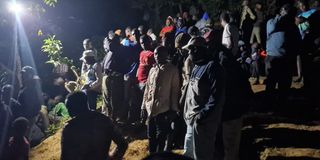
A gold mine collapse in Shinyalu, Kakamega County, has left several miners trapped and feared dead.
recently witnessed small-scale miners ferrying sacks of soil scooped from the mine sites.
According to the Sakuye community spokesperson Abdi Guyo, despite the government’s radical decisions to ban mining activities in seven sites and to refill all the pits that caused deaths of over 40 people, miners are still going there.
“I can tell you as a resident of Dabel Division that more than 100 lives have been lost in illegal mining activities in the gold sites before the government decided to refill the pits. Even today, illegal mining still continues in the closed sites,” Mr Guyo said.
The most recent deaths reported in the site involved 18 illegal miners in November 2024.
Marsabit County Commissioner James Kamau told journalists in early April that the gold mining in Marsabit was a precarious venture as even outlawed groups from neighbouring Ethiopia and Somalia also asserted their commands within the sites.
In Nandi County, the search for justice has been elusive for families of three miners killed in a blast at the Karebe gold mine after the Office of Director of Public Prosecutions (ODPP) terminated the case against 10 suspects linked to the incident and ordered a fresh investigation.
Geoffrey Kipchirchir Rotich, 39; Geoffrey Onyango, 33; and Julius Kipchumba, 41, were the victims of a collapse that happened when a rival company blasted an adjacent wall while they were at work.
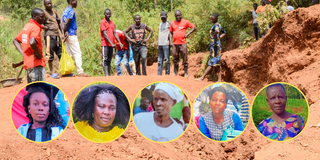
Viola Aluoch Onyango, Cathy Akinyi Okach, Mathlida Aoko Awuor, Millicent Akinyi and Caroline Atieno died in a gold mine collapse in Siaya County on March 4, 2025.
Mr Rotich’s widow, Caroline, said: “Life has taken a turn for the worst since my husband died in the gold mine explosion two years ago. While the mining company has not honoured its pledge to offer moral and financial support apart from paying fees for our children, legal proceedings against suspects implicated in the crime seems to have hit a brick wall.”
Karebe Gold Mining Company Limited Managing Director Charlie Tryon said the firm was demanding justice for the workers killed in rivalry over mining rights.
But the rival company has claimed that it has a licence to mine in the disputed land.
Kerebe has been given exclusive gold mining at Nandi escarpment for 25 years.
In Siaya County, one of the most recent gold mine deaths was witnessed on April 1, where three artisanal miners lost their lives after they were buried in a mine shaft. They were Duncan Ooko, 33; Elphas Odhiambo, 21; and Allan Ochieng, 35.
The scene now is eerily silent, with no one present to continue with the search for the precious mineral.
“We have shut the operations for now after the deaths of the three artisanal miners,” said the area assistant chief, Mr Edwin Juma.
Few kilometres away, in the neighbouring Rarieda sub-county, five female artisanal miners were covered with a heap of soil at Lumba gold mines in March.
Mr Oduma Ayugi, who lost a relative in the incident, said the family is yet to recover from the shock of losing kin among the five women.
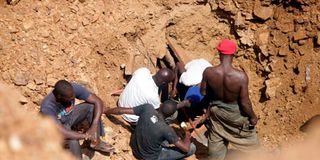
Rescue operations at a collapsed gold mine in Abimbo village, Siaya County, in December last year.
“To the family members who lost their kin at the mines, it is a nightmare. Every time we hear the sound of crushers, it is reminding us of what robbed us of our loved ones,” said Mr Ayugi.
He blamed the poverty in the region as the sole source of the deaths: “The shaft owners have turned deaf ears to the voice of reason and have continually taken advantage of the poverty of the local population and exploited them.”
Still in Siaya County, Gem sub-county lost three young men in February. Stephen Odhiambo, 24; Musa Owino, 30; and Moses Onyango, 33, met their deaths after a shaft caved in.
Mr Kennedy Ogola, chairman of the artisanal miners in Rera said the precautions and safety measures have always been a priority.
“It is painful that we lost very young and vibrant men. We are still in shock of what befell us back on February 25,” he said.
Mr George Ogada, Stephen Odhiambo’s father, is still lost in thoughts over what befell his child.
“I have no words to express what I feel. It is too much just imagining that my son is no more,” he said in a distraught voice.
The same applies to Richard Ombima who is still coming to terms with the loss of his brother-in-law, Musa Owino.
In Turkana County, the November 18, 2024 incident where three artisanal miners lost their lives at the Naduat gold mine is still fresh in locals’ memories.
One of the survivors, Mr Erukudi Ewesit, said that it was just a normal day for a group of 10 miners who had high hopes of striking gold from Lomeguro Gorge.
“Without any order, we began descending into the shaft, anticipating a better day. Everyone must climb down the 200-meter-timbered shaft with horizontal turns,” Mr Ewesit recalled to Sunday Nation.
He recalled that two of his colleagues and a child who were ahead of him were buried alive with walls caved in.
“We were forced to amputate the arm of Lantos Kalei after it was stuck in the rubble for him to be safe following interventions from Kenya Red Cross, security officers, and county government officers who came for the rescue operation,” Mr Ewesit said.
Mr Andrew Akolong, the area chief, said that it was the first time for the Lomeguro Gorge, one of the oldest ones, to cave in.
In neighbouring West Pokot County, four people were buried alive in the gold pits at the Lami Nyeusi area On December 17, 2024, in June 2024. Two male adults were buried alive in gold mines in the Kambi Karaya area along the Lodwar-Kitale highway.
In 2023, three women were buried alive in the gold mines in the Kambi Karaya area along the Kitale Lodwar highway. The same year, one person died and another escaped death narrowly after they were buried alive in a collapsed mine in Porokoyo village.
Reporting by Shaban Makokha, Jacob Walter, Barnabas Bii, Kassim Adinasi, Sammy Lutta and Oscar Kakai



